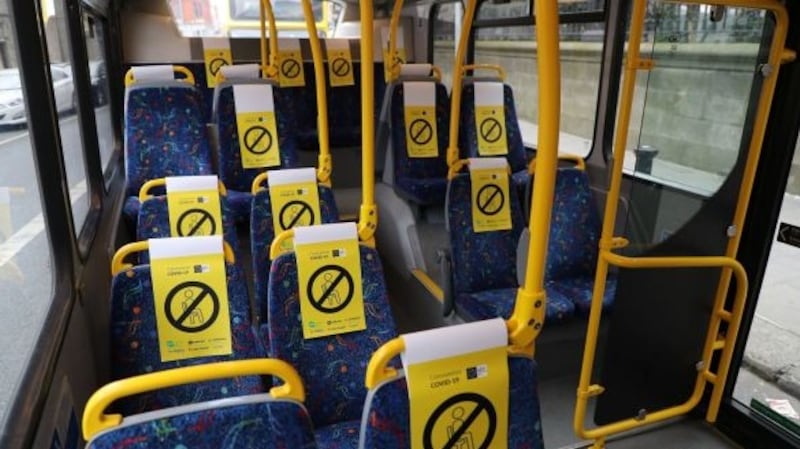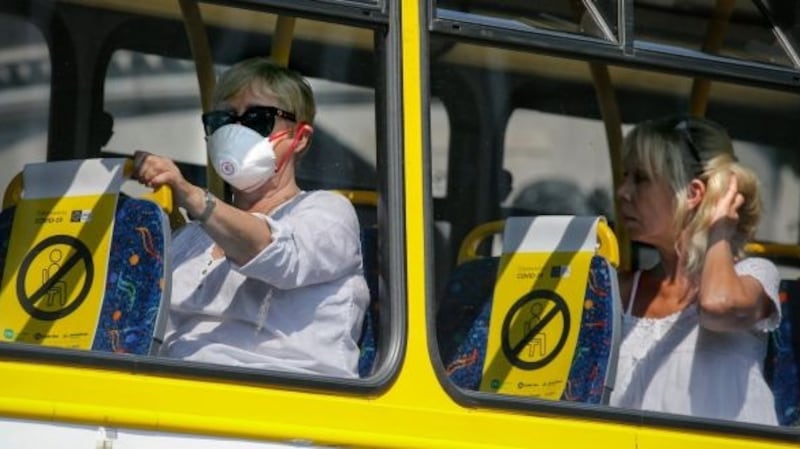Over the summer public transport officials held a series of meetings with employer groups and third level colleges, facing an unprecedented need to gauge passenger demand from next month as “normal” post-summer life resumes.
The problem of course is that life will not return as normal. Trains, trams and busses will operate much differently and planners must consider what transport in Ireland will look like toward the end of 2020 and into 2021.
With strict social distancing requirements slashing capacity and many thousands of people planning to remain working from home, the focus will be on those who have no choice but to get back on board.

Detailed data obtained by The Irish Times shows very clearly the cataclysmic effect Covid-19 has had on public transport use, at one point shedding about 90 per cent as society shut down to contain the virus.
Looming concerns will include the relationship between demand and supply; public safety; how commuters might be persuaded to change their travel patterns; and the prospect of more people opting for private cars.
The challenges for what might come are best understood by looking at what has happened so far – in early March, the national transport network came to a grinding halt. As Ireland locked itself away, only a scattering of essential workers climbed on board carriages and buses, making their way to work through empty streets, enjoying a near perfectly functioning system.

"It fell off a cliff. We went from pushing 1 million passengers a day to very low numbers; just under 100,000 at one point and that stayed the case for the bulk of March and into April. It was really only when things started to open up in May [that numbers began to recover]," explained Tim Gaston, director of public transport services at the National Transport Authority (NTA).
Its data is stark, illustrated on graphs, as with most things related to the pandemic, by a precipitous downward curve.
Transport use by numbers
As a whole, daily PSO (public service) passenger numbers dropped from more than 950,000 at the very beginning of March, to consistently, and often well below 100,000, between the end of March and into May. On March 5th, just before the plummeting decline, the country’s first clusters of coronavirus were confirmed.
A swift and steady collapse followed. By the very end of that month, when transport use dipped and remained steadily below the 100,000 figure, it coincided with then taoiseach Leo Varadkar’s appeal to the nation to stay at home.
The so-called 2km rule was introduced, all but emptying public transport vehicles, with the only travel exceptions permitted for health, social care or other essential work as well as shopping for food or attending medical appointments.
A seven day rolling average of the data – which flattens out the peaks and troughs of weekend and weekday usage – shows that Dublin Bus, which had carried by far the largest number of commuters of all services before the pandemic, began to grow consistently beyond the 100,000 mark in early June.
This occurred just as Ireland was entering phase two of the lifting of Covid-19 related movement restrictions.
By April and early May, Luas usage had shrank to as low as 3 and 4 per cent of its late February level. On March 10th, it had almost 142,000 passenger journeys compared to just under 5,500 on April 18th (a Tuesday and Saturday respectively).
Similarly, Bus Éireann had dropped to as low as 5 per cent of passenger use when comparing mid-April with early March. 118,000 passengers on Friday, February 28th, had fallen to 14,700 by Friday, April 17th.
On Monday, March 9th, Irish Rail recorded slightly over 198,500 passengers, but by Monday, April 13th, it was just over 2,000.
The rural Local Link bus service has seen the fastest recovery during the Covid emergency, having already arrived back at the level of use it experienced in early March.
Uncertain future
And yet, recovery across the network is not straightforward – accompanying an ongoing social discomfort and wariness, is the Government mandate that each individual vehicle can only be used to half its capacity.
Exactly how the network responds or bounces back in the coming months will depend on a complex interplay of demand, capacity, individual confidence and what many believe will be a shifting culture in work habits.
“Will the long distance commute be changed permanently? I think that’s possible,” said Mr Gaston. “On the other hand, people might find that working from home isn’t that great and might want to go into the office.”
September will tell, or begin to tell, but immediately travellers will be faced with the measures that Irish transport authorities have put in place. Aside from capacity reduction, Ireland was one of the first countries to use seat covers with concise Covid-19 messaging across the network.
Daily cleaning was introduced, as was protection for drivers. Since July face coverings became mandatory and compliance, according to officials, has been very high.
While the system seems primed, efforts are well under way to try and understand what it might have to contend with, in so far as that is possible.
The NTA has had a number of meetings with employers groups including Ibec and Chambers Ireland, as well as with third level educational institutions. The idea is not just to try and gauge how many people might be standing on platforms and at bus stops from early September, but to try and encourage a shift in behaviour that would keep limited capacity free for those with limited capacity to alter their travelling timetables.
There have already been shifts. In the Covid era, people have been increasingly travelling at quieter times, notably between 10am to 2pm. Although there is less capacity on the network, this fanning out of commuter demand would greatly increase efficiency in the use of what capacity is available.
Transit authorities in a number of countries are beginning to send out a similar message.
“For those who have the choice we would be very keen to see them either not using public transport at all, and continuing to walk and cycle, or if not, to spread their start times [in work],” Mr Gaston said.
“Behaviours can be changed if people understand the reasons for it and if it still provides the services that they need.”
October and November will be an early test – these are traditionally the busiest months on public transport with workers less inclined to take holidays and students in classes full time.
Commuter flexibility
The NTA has raised the issue of working hour flexibility, particularly now that a grand experiment has proved the ability for large swathes of the working population to do so from home, even if just on a part time or shared basis.
"At the minute the discussion is more around do [employers] see them returning to the office," Mr Gaston said. (Tech companies such as Google and Facebook are allowing employees to remain at home, at least in the short term).
“The strong sense that we are getting is that there will not be the same massive return in September of workers.”
However, the question of Irish transport and population mobility is more complicated than what happens in the coming months and Covid has thrown it into sharp, often urgent focus.
The urgency for some comes in the form of private car use which had come back much faster than public transport for obvious reasons (although Mr Gaston said this had levelled off against a slow but steady rise in public transport).
Faced with similar problems, Transport For London recently acknowledged the post-recovery need for “safe space for people to use active, sustainable and socially distanced modes of travel”, that would help prevent a “damaging car-led recovery”.
"We must avoid a car-led recovery which would cause gridlock and only make things worse," said transport commissioner Andy Byford. "So my message to Londoners returning to public transport is we are doing everything to keep things clean and safe for everyone."
Conor Faughnan, director of consumer affairs at the AA, said while the roads were extremely quiet on the June bank holiday weekend, the August bank holiday was almost the same as last year. While the private car is in resurgence, much like public transport the next couple of months will be the true test.
So far, noted Mr Faughnan, there has been no return to morning rush hour traffic and businesses are still working out what to do with employees.
“There may be some sort of new paradigm,” he said. “We will just have to wait and see.”
Opportunity
David O’Connor, transport expert and assistant head of school at TU Dublin Environment and Planning, believes Covid has brought about an opportunity for the sector.
He sets out an immediate future of fewer passengers, higher costs and a work operating environment that for safety and health concerns, could make more people inclined to opt for the shelter of their own cars.
“They are putting in cycling and walking measures but they should also be looking at putting in public transport measures as well,” he said.
“As a planner I can see that everything is changing; the rule book has been almost thrown out.”
The performance of public transport timetables during the pandemic lockdown offered a brief taste to Irish commuters, albeit a small number of them, of how networks operate in cities like Zurich and Stockholm, he said. A positive legacy of this 21st century pandemic could be transport investment.
“The idea behind Bus Connects becomes even more strategic,” he said, adding that the time is arguably now to embrace “smoothed travel patterns”, essentially doing away with two rush hour peaks; redesigning transport vehicles to give passengers greater space; and providing hand sanitiser to compliment the wearing of masks.
“The most important thing is to do this carefully. We have to look to the future; I think there will be a different set of urban economics when we come out of this. Not everybody is going to go into work five days a week.”











